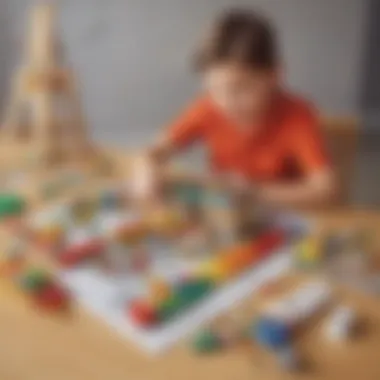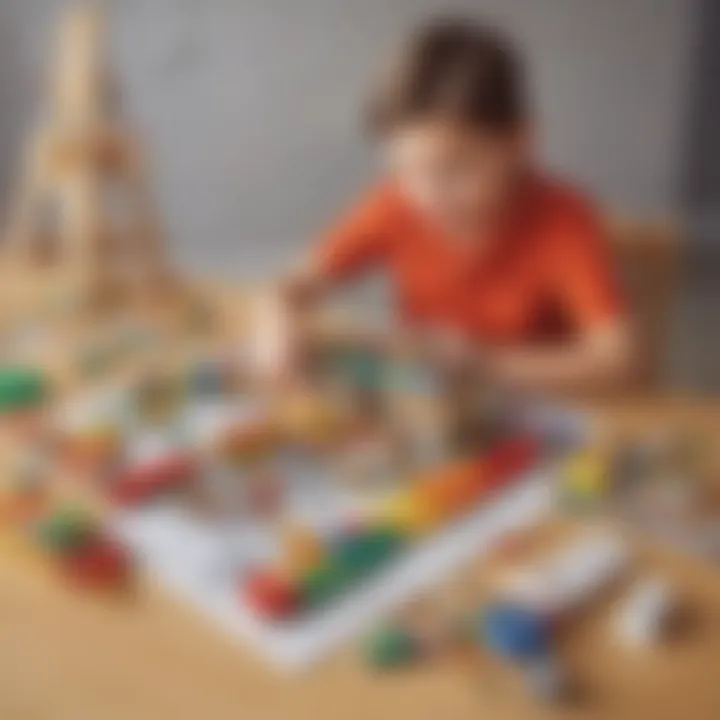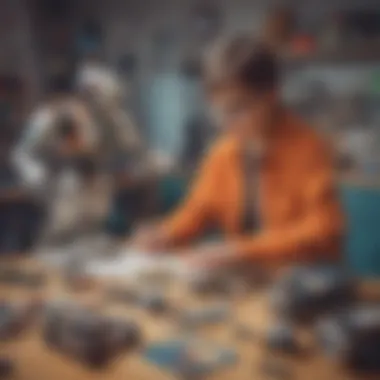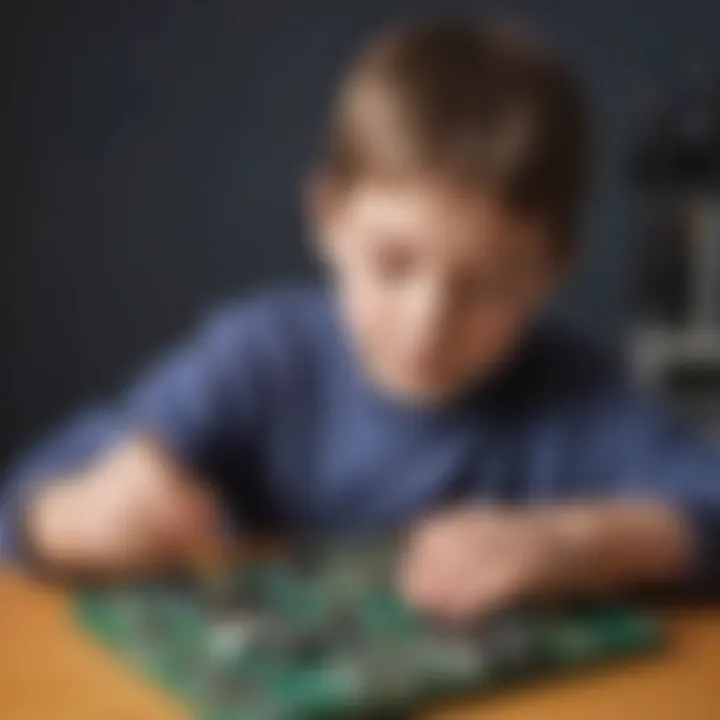Top Engineering Toys to Inspire Young Innovators


Intro
Toys play a pivotal role in shaping the future skills of children, especially in engineering. Each toy introduces unique concepts and challenges that can stimulate young minds to think critically and creatively. The idea here is to understand how certain toys can be more than simple distractions; they serve as tools to enhance essential engineering competencies.
Parents and educators often seek insightful resources that highlight the kinds of toys that can contribute to a child’s development. Engineering skills are crucial not just for future engineers, but also for problem-solving in everyday life. Having the right toys can cultivate these skills.
As we explore this topic, it becomes important to analyze different types of toys. This narrative will delve into items that spark interest in engineering and design, address how they achieve this, and offer guidance on how to select suitable options based on a child’s age and interest level.
Science Fun Facts
Understanding engineering principles can be fun, especially when it includes interesting facts that captivate children's imagination.
- Did you know that the Eiffel Tower can be 15 cm taller during the summer? The heat causes the iron to expand!
- The Great Wall of China is not visible from space without aid. It's one of the most ambitious construction feats in history.
- LEGO bricks were first manufactured in 1949 and still inspire millions of children to create unique structures.
Toys that encourage the investigation of physical properties and structural design are very impactful. For instance, building sets allow children to explore these fun facts through play while incorporating key principles of engineering.
"Toys can inspire learning and creativity by creating a safe environment for failure and exploration."
Interesting Trivia and Facts
- The tallest building in the world is the Burj Khalifa in Dubai, standing at an astounding 828 meters.
- The oldest known toy is a doll over 4,000 years old, found in ancient Egypt. It reflects how children have always had a desire to create and play.
Discover the Wonders of Engineering
Exploring engineering through toys opens doors to various scientific concepts. Children organically learn about mechanics, structures, and systems by manipulating these toys.
Educational Videos and Animations
These can effectively complement a child’s play with toys. Many resources summarize engineering principles in accessible formats. Websites like Wikipedia or Britannica provide foundational knowledge if parents want to dive deeper.
Interactive Learning Tools
To encourage exploratory learning, tools like K’nex or Snap Circuits engage children in hands-on activities. These materials allow learners to connect the dots between theory and practical application.
Real-Life Applications of Engineering
When children understand how toys represent real-world concepts, they become more engaged. Projects like building bridges or simple machines demonstrate critical thinking in real-time.
Science Quiz Time
Introducing a quiz format could serve as an engaging way for children to assess their learning. Quizzes can be structured to evaluate knowledge around engineering concepts used in various toys.
Interactive Quizzes
- What material is commonly used in construction due to its strength?
- Name one popular toy that allows building with blocks?
These questions prompt reflection on the principles learned while playing.
Science Experiment Showcase
To further reinforce skills, parents can organize fun science experiments using common materials found at home.
Fun and Engaging Experiments
- Building a Simple Bridge: Use straws to demonstrate how structures can hold weight.
- Balloon-Powered Cars: Create a simple vehicle powered by air, introducing physics concepts.
Step-by-Step Instructions
- Collect materials like straws, tape, and a balloon.
- Discuss what makes a design stable and strong.
Materials List
- Plastic straws
- Tape
- Balloon
Safety Tips and Precautions
Always supervise children during experiments, especially those involving potential hazards.
This overview underscores how toys can foster valuable engineering skills. By encouraging curiosity and exploration through well-chosen toys, parents and educators can create a strong foundation for future problem solvers and innovators.
Prologue to Engineering Toys


Engineering toys play a crucial role in the development of young minds by fostering creativity, problem-solving abilities, and critical thinking skills. These toys are not merely tools for entertainment; they serve as educational instruments that introduce children to fundamental engineering concepts. By engaging with these toys, children learn to design, build, and troubleshoot, all of which are essential skills in the modern world.
The choice of toys has a profound impact on the learning process. When parents and educators introduce engineering toys, they encourage children to engage in hands-on exploration. This active involvement not only makes learning enjoyable but also reinforces concepts that children may learn within a classroom. In an era where STEM (Science, Technology, Engineering, and Mathematics) skills are increasingly valued, fostering an early interest in engineering through play can yield great long-term benefits.
The Role of Play in Learning
Play is often regarded as a child's primary mode of learning. Through play, children can experiment with different ideas and concepts without the fear of failure. Engineering toys allow them to build structures, create designs, and solve problems, all within a playful context. For instance, by manipulating building blocks or construction sets, children understand basic physics principles like balance and stability.
Furthermore, innovative toys that challenge children's thinking can stimulate curiosity. Playful exploration nurtures a willingness to test hypotheses and learn from mistakes. This iterative process of trial and error is fundamental in engineering, as the field often requires individuals to find solutions to complex issues. By associating learning with fun and creativity, children are more likely to develop a positive attitude towards educational pursuits.
Why Engineering Skills Matter
The cultivation of engineering skills in children is increasingly important in today's technology-driven society. Engineering involves more than just building and constructing; it encompasses critical thinking, analytical reasoning, and creativity. In a time when many industries are rapidly evolving, having a foundation in engineering principles can prepare children for diverse career opportunities in the future.
Moreover, engineering skills have applications beyond traditional engineering roles. Skills such as problem-solving, teamwork, and project management are valuable in various fields including medicine, finance, and environmental science. Thus, by investing in engineering toys, parents and educators can provide children with a versatile skill set that will serve them throughout their lives.
Criteria for Selecting Engineering Toys
Choosing the right engineering toys involves careful consideration. It is crucial to evaluate various aspects that influence educational value, engagement, and ultimately the child’s development. Each child is unique, and selecting the most appropriate toys can significantly impact their understanding of engineering concepts. Here, we delve into the critical criteria that every caregiver should consider when selecting engineering toys.
Educational Value
When considering toys, educational value is paramount. The primary goal of engineering toys is to foster learning through play. Toys should challenge children’s thinking and problem-solving abilities. For instance, a set of mechanical gears introduces basic physics principles. Children learn how different gears interact while experiencing hands-on creation. A toy should not merely entertain; it should also stimulate curiosity, encourage exploration, and promote critical thinking skills. The best toys provide opportunities for children to apply math and science concepts in practical scenarios, making learning engaging.
Age Appropriateness
Age appropriateness is another significant factor in selecting the right toys. Toys designed for older children may be too complex for younger ones, leading to frustration instead of learning. Conversely, toys intended for younger kids might not challenge older children enough. Understanding the developmental stages of a child is vital for selecting toys that match their cognitive skills and motor abilities. For example, a robotics kit for teenagers may involve programming and coding, while a building set for toddlers enables them to learn through simple stacking and balance. Choosing the right age-appropriate toys ensures that children remain enthusiastic and engaged without feeling overwhelmed or bored.
Safety Considerations
Ensuring the safety of toys cannot be overlooked. All toys must adhere to safety standards relevant to the child’s age group. Toys should be free from sharp edges and toxic materials that could harm children during play. Checking for safety certifications is essential. Materials like BPA-free plastics or lead-free paints indicate a focus on safety. Furthermore, smaller parts shouldn’t be present in toys meant for younger kids to avoid choking hazards. By prioritizing safety, caregivers can create a secure play environment that encourages exploration, invention, and learning.
"Play is essential for children’s development. Choosing the right toys shapes their learning experiences as future engineers."
Building Blocks and Construction Sets
Building blocks and construction sets are fundamental to the world of engineering toys. These toys provide foundational skills that are essential for young learners. Not only do they serve to enhance fine motor skills, but they also promote spatial awareness, problem-solving abilities, and creativity. When children engage with building toys, they experiment with various designs, which ultimately helps nurture their engineering mindset. This section explores the types of building toys available and the educational benefits they offer.
Types of Building Toys
There is a wide variety of building toys available on the market today. Among the most popular types are:
- Traditional Wooden Blocks: Simple yet effective, these blocks allow children to create virtually anything. Their tactile nature enhances sensory development.
- LEGO Sets: Known worldwide, LEGO encourages imaginative play. It offers numerous themes, from architectural designs to vehicles.
- Magnetic Tiles: These invite children to utilize magnets to construct colorful structures. They encourage creativity while demonstrating basic physics principles.
- K'NEX and Other Construction Systems: These kits use rods and connectors. They allow for complex building, which can lead to more intricate designs.
Each of these toys can serve diverse age groups and skill levels. Parents should choose based on their child's preferences and age appropriateness.
Educational Benefits of Building Sets
The educational benefits of construction sets are extensive. They include:
- Promoting Critical Thinking: When children face building challenges, they must think critically to find solutions. This process fosters essential analytical skills.
- Enhancing Collaboration Skills: Often, building toys are played with in groups. This collaboration develops communication and teamwork skills.
- Understanding Geometry and Physics: As children build, they encounter basic principles of physics and geometry. They learn about balance, weight distribution, and spatial relationships.
- Encouraging Persistence: Building can be a trial-and-error process. When children initially fail to create what they envision, they learn to persist and try again.
"Play is the highest form of research." – Albert Einstein
Parents and caregivers should consider incorporating building toys into their children's playtime to foster these important skills.
Robotics Kits
Robotics kits play a crucial role in nurturing future engineers. They combine elements of science, technology, engineering, and mathematics (STEM) in a single package that encourages children to engage with core concepts through hands-on experience. As the world moves increasingly towards automation, understanding robotics will be essential for the next generation. These kits not only provide an exciting learning opportunity but also foster skills that go beyond simple mechanical assembly. From programming to designing, robotics kits offer a comprehensive educational experience.
Prolusion to Robotics
Robotics is the branch of technology that involves the design, construction, operation, and use of robots. For children, exploring robotics can start as early as elementary school. The introduction to robotics can ignite an interest in engineering, mathematics and coding. Early exposure to these concepts prepares children for advanced topics later in their education. Kits often include various components such as motors, sensors, and controllers, enabling children to build functioning robots.
Popular Robotics Kits for Children
Several robotics kits stand out in the market for their ability to enhance learning and engage young minds. Here are some well-regarded options:
- LEGO Mindstorms: This kit allows children to build programmable robots using LEGO bricks. Its versatility and ease of use make it extremely popular.
- VEX Robotics: Aimed at older children, it offers a more complex building experience with various components and programming capabilities.
- Botley 2.0: An entry-level robot that teaches coding without a screen. Children can program it using simple instructions.
- Thames & Kosmos Robotics: Smart Machines: Combining scientific concepts with fun, this kit encourages children to design robots while learning about engineering principles.
Each of these kits provides different levels of complexity, ensuring that there is something available for every age group. This variety in offerings helps capture the interest of diverse learners.


Skills Enhanced by Robotics
Engaging with robotics kits helps children develop a range of valuable skills:
- Critical Thinking: Building and programming robots requires logical reasoning and problem-solving abilities, essential for future engineers.
- Creativity: Kids use their imagination to design and create unique robots, fostering an innovative mindset.
- Teamwork: Many robotics projects are collaborative. Children learn to communicate ideas and work together, skills important in any field.
- Technical Skills: Understanding basic engineering and programming concepts lays the groundwork for advanced studies in these areas.
Robotics kits offer a unique blend of learning and fun. By providing children with the tools to build their own robots, these kits not only entertain but also educate. This foundation in robotics will serve them well as they grow, whether they pursue a career in engineering or another STEM field.
"The most important thing is to have fun while you are working on robotics and learning a lot in the process."
In summary, robotics kits are an invaluable resource for children. They offer engaging challenges that develop critical skills necessary for the engineering landscape of the future.
Engineering Science Kits
Engineering science kits are critical components in nurturing the engineer's mindset in young learners. These kits usually merge practical and theoretical knowledge, encouraging children to explore various engineering principles through hands-on activities. This method of learning not only solidifies concepts but also ensures that kids remain engaged and excited about the sciences.
Exploration of Science Kits
Science kits give children a platform to actively engage with key scientific concepts. They allow kids to experiment and discover while having fun. For example, kits that explore chemical reactions can assist them in understanding basic principles of chemistry. They may mix substances and witness reactions, which can spark curiosity about the natural world.
The following aspects are fundamental when exploring science kits:
- Hands-On Experience: Kids get to physically manipulate materials, making learning more effective.
- Problem Solving: Many kits challenge children with tasks that require them to think critically and resolve issues.
- Safe Experimentation: Age-appropriate kits offer a safe environment for young minds to experiment without the risks associated with real-life applications.
One popular choice is the Thames & Kosmos Chemistry Set. This kit encompasses various experiments that encourage exploration and learning, offering a blend of fun and education. Such kits provide a unique experience where curiosity meets creativity.
Interdisciplinary Learning through Science Kits
Science kits do not simply cater to one field of study; they promote interdisciplinary learning. By combining engineering, art, technology, and mathematics, kids gain a comprehensive understanding of related concepts. For instance, creating a simple machine generates interest in physics and mechanics, while a solar-powered project can introduce children to renewable energy concepts.
Benefits of interdisciplinary learning:
- Holistic Understanding: Children can see connections between different subjects, enriching their educational experience.
- Enhanced Creativity: Engaging in various disciplines fosters creativity, leading to innovative solutions to problems.
- Preparation for Future Challenges: Knowledge from multiple domains equips them with skills essential for multidimensional real-world tasks.
Utilizing kits like Snap Circuits allows children to explore electronics while reinforcing math and physics concepts. Such experiences make education both enjoyable and effective, setting young engineers on a path for success.
"Science kits are the bridge between theoretical knowledge and real-world applications. They inspire curiosity and fuel creativity."
STEM Puzzle Games
STEM Puzzle Games play a crucial role in nurturing young minds equipped to think critically and solve problems efficiently. These games foster creativity and analytical skills essential for future engineers. In this article, we will explore the significance of puzzles in learning, the skills they promote, and recommend some engaging options for children of various ages.
Importance of Puzzles in Learning
Puzzles are not merely entertaining activities; they are powerful educational tools. Engaging with puzzles encourages children to develop various cognitive abilities. Problem-solving is the most significant area where puzzles shine. As children confront the challenge of placing pieces together or solving a complex problem, they begin to understand how to approach difficulties logically.
Additionally, puzzles enhance spatial reasoning. Skills like visualizing how different shapes fit together can translate into engineering tasks later in life. Completing puzzles also helps children improve their memory and concentration. Activities that require focus can lead to better academic performance in school.
"Puzzles are a fun way to help your child think creatively and develop solutions to complex problems."
Furthermore, these games can enhance teamwork and communication skills. When children work in pairs or small groups, they learn to express their thoughts clearly and listen to others' ideas. This interaction is vital for future collaboration in engineering and technology fields.
Recommended STEM Puzzles
When seeking puzzles for young learners, it is essential to choose those that stimulate their creativity and align with STEM principles. Here are some recommended options:
- Gravity Maze by ThinkFun: This game combines logic and engineering. Children build a marble run, reinforcing their understanding of cause and effect.
- Ravensburger Puzzle Sets: These sets come in various themes and complexities. They challenge spatial reasoning and attention to detail. Gradually increasing the difficulty encourages children to persist and improve.
- SmartGames IQ Puzzler Pro: includes 3D puzzles that promote logical thinking and planning. It offers varying levels of difficulty, catering to different ages and skills.
- Rush Hour Logic Game: This game involves moving cars to escape a traffic jam. It enhances problem-solving skills in a fun environment.
- GeoSafari Jr. Talking Microscope: While not a traditional puzzle, it encourages exploration and curiosity in science and nature. The interactive aspect keeps children engaged.
Electronic Circuit Kits
Electronic circuit kits serve as a pivotal tool in the development of engineering skills in children. These kits engage young minds in the world of electronics, making it approachable and fun. They encourage exploration of concepts such as voltage, resistance, and current through hands-on projects. Mastering these fundamental concepts is critical for budding engineers, as it lays the groundwork for various fields in technology and engineering.
Understanding Basic Electronics
Basic electronics is the bedrock of many engineering disciplines. Learning the principles of how circuits function provides insight into how our modern world operates. Beginning with simple components such as resistors and capacitors, children can grasp essential concepts.
Through electronic circuit kits, young learners can:
- Experiment with circuits: By following manual instructions, they will learn how to create various circuit configurations.
- Understand series vs. parallel circuits: Grasping differences between these types can provide vital insights for complex designs.
- Connect theory to practice: Each project reinforces theoretical learnings, bridging gaps between abstract concepts and practical application.
Hands-On Learning with Circuit Kits


Hands-on learning is particularly effective for young learners. Electronic circuit kits afford children the flexibility to build, dismantle, and rebuild circuits. The tactile nature of working with real components enhances memory retention and understanding.
Key benefits of hands-on learning with these kits include:
- Boosting problem-solving skills: When projects do not work as intended, children learn to troubleshoot issues.
- Fostering creativity: They can design their own circuits after completing guided projects, allowing for personalized expression.
- Building confidence: Successfully completing projects empowers children, which boosts their interest in engineering.
"Hands-on activities have the possibility to create a significant impact on learning outcomes."
Craft and Design Kits
Craft and design kits are integral in stimulating a child's creativity and problem-solving abilities. These kits offer an hands-on approach to learning, encouraging aspects of engineering that involve design thinking, iteration, and innovative solutions. Craft kits can come in various forms, such as materials for building, textiles for sewing, or even components for electronics. The diverse nature of these kits aligns well with engineering principles, as they often require critical thinking and an understanding of basic design.
Through the process of creating something tangible, children engage with concepts that are germane to engineering. This can involve planning their projects, managing resources, and troubleshooting when things do not go as expected. Craft and design kits do not merely represent passive activities; instead, they cultivate an environment where young minds can explore and test their ideas.
Exploring Creativity through Craft Kits
Creativity is at the heart of engineering. When children use craft kits, they are not just creating something decorative or functional; they are also learning to innovate. These kits typically enhance imaginative play, enabling a fusion of art and science. For example, a basic craft kit may include materials like paper, glue, and various tools that can inspire children to come up with unique creations, merging engineering concepts with artistic expression.
The benefits of engaging with craft kits are manifold:
- Skill Development: Children learn to manipulate various materials, expanding their dexterity and hand-eye coordination.
- Problem-Solving: Every project inevitably presents challenges, prompting children to devise practical solutions on their own.
- Collaboration: Many craft projects can be done in groups, teaching children the value of teamwork and shared ideas.
Thus, using craft kits can be a meaningful way to explore creativity while simultaneously nurturing an engineering mindset.
Engineering Concepts in Design Projects
Design projects through craft kits provide an excellent opportunity to apply basic engineering principles in a fun, engaging way. Whether it’s constructing a model bridge or designing a functional piece of furniture, these projects help to instill foundational concepts that are vital in engineering. Moreover, children learn about material properties, structural integrity, and constraints that professionals face.
Some core engineering concepts students may encounter include:
- Measurement and Precision: Understanding dimensions and accurate measurements is essential.
- Material Choices: Different materials behave differently; knowing which to use is a fundamental engineering decision.
- Functional Design: Projects often focus on functionality, prompting children to think critically about how to make their creations useful.
Learning these concepts through interactive design projects makes complex ideas more accessible. Overall, craft and design kits serve as a bridge, leading young learners from play into the practical realm of engineering, thereby preparing them for more advanced challenges in the future.
Craft kits transform educational experiences into enjoyable, hands-on adventures, fostering both creativity and engineering skills.
3D Printing Toys
3D printing has revolutionized the way people create objects. For children, it offers a hands-on approach to learning. With 3D printing toys, kids can design and make their own creations. This technology ignites imagination and nurtures problem-solving skills. As more schools incorporate 3D printing into their curriculum, understanding its benefits becomes essential for future engineers.
Prologue to 3D Printing for Kids
3D printing for kids introduces them to the concepts of design and engineering in an engaging manner. Children can use software aimed at their age level to create their own models. Once designed, these models can be printed into tangible objects using a 3D printer. This process allows children to see their ideas come to life. By engaging in this, they learn about dimensions, scale, and the engineering design process.
The age-appropriate software available often includes tutorials and challenges to guide young users. The accessibility of 3D printing in homes and schools has grown, making it a viable tool for education.
Benefits of 3D Printing in Engineering Education
Utilizing 3D printing in engineering education offers multiple benefits:
- Creativity Enhancement: Kids can visualize concepts in a new way, transforming ideas into physical forms.
- Problem-Solving Skills: Designing requires students to think critically, ensuring they consider how the object will function.
- Technical Proficiency: Learning to operate a 3D printer and design software fosters technology skills.
- Collaboration: Many projects can be done in teams, teaching kids to work with others to solve problems.
3D printing not only prepares learners for future careers in engineering but also promotes essential life skills.
3D printing toys serve as excellent tools to introduce children to engineering principles. By incorporating design, creativity, and technical skills, these toys play a significant role in stimulating young engineers' minds.
Final Thoughts on Choosing Toys for Future Engineers
Selecting the right toys for young learners, specifically those that inspire engineering skills, is a thoughtful process. It goes beyond mere entertainment. The toys children engage with can shape their understanding of core concepts and influence their future learning paths. Parents and educators should prioritize toys that nurture creativity, problem-solving abilities, and critical thinking.
Encouraging Lifelong Learning
Encouraging a love for learning in children is vital. When they play with engineering toys, they often encounter challenges that require innovative solutions. This not only enhances their cognitive skills but also fosters a growth mindset.
Benefits of nurturing lifelong learning include:
- Critical thinking: Engaging with complex toys requires children to analyze situations and make decisions.
- Resilience: Learning through play often involves trial and error. Children learn to persist in the face of difficulties.
- Curiosity: Exposure to diverse tools and concepts sparks questions and encourages exploration.
To help develop these attributes, parents can create environments where curiosity is encouraged. Asking open-ended questions during play can deepen understanding and fuel interest.
Using Toys to Cultivate an Engineering Mindset
To cultivate an engineering mindset in children, toys should encourage exploration and experimentation. Engineering is not just about mechanics; it involves designing solutions to real problems. Crafts, circuit kits, and robotics all provide concrete experiences where children can test their ideas.
Here are some effective ways toys help build this mindset:
- Hands-On Experience: Toys that allow for building, programming, or crafting give children the chance to actively participate in their learning.
- Problem-Solving: Many engineering toys present challenges that require strategic thinking to overcome.
- Collaboration: Some toys encourage group play. Working with others can help develop communication and teamwork skills essential in engineering fields.







